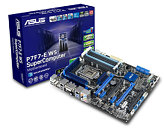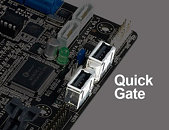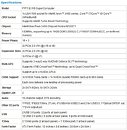Tuesday, March 16th 2010

ASUS Introduces P7F7-E SuperComputer Motherboard with Next-Gen Connectivity Features
ASUS today announced the launch of the new ASUS P7F7-E WS SuperComputer motherboard which maximizes transmission speeds by integrating the industry's latest I/O technologies such as USB 3.0, SATA 6G storage interface, and IEEE 1394b FireWire standard. Additionally, the ASUS P7F7-E WS SuperComputer is equipped with the LGA1156 socket and the latest Intel 3450 chipset with onboard graphics. For extreme gaming enjoyment, up to four ATI CrossFireX cards or 3-way/2-way NVIDIA SLI cards can be accommodated to generate smoother and sharper visuals. It also leverages NVIDIA CUDA parallel computing architecture to support up to four NVIDIA Tesla cards with Clarkdale Processors for intensive high-performance computing.
The ASUS P7F7-E WS SuperComputer is the best choice for providing comprehensive I/O support. It includes USB 3.0 ports-the latest connectivity standard with 4.8Gb/s speeds-to support next-generation components and peripherals. USB 3.0 transfers data ten times faster and is backward compatible with USB 2.0 components. Additionally, the ASUS P7F7-E WS SuperComputer includes Serial ATA (SATA) 6Gb/s storage interfaces for 6.0Gbps data throughput, thus enhancing scalability, accelerating data retrieval, and doubling the bandwidth of current bus systems. To support FireWire-enabled digital video recorders and computers, the ASUS P7F7-E WS SuperComputer also includes two IEEE 1394b ports supporting up to 800 Mb/s speeds-doubling the previous IEEE 1394a speeds.Massive Computing Power up to 4 Teraflops with CUDA Parallel Processing
A powerful and efficient platform, the ASUS P7F7-E WS SuperComputer supports high-performance computing for life sciences research, engineering and financial modeling with its NVIDIA CUDA parallel computing architecture. By accommodating up to four NVIDIA Tesla cards with built-in Clarkdale processors, the ASUS P7F7-E WS SuperComputer generates up to 4 Teraflops of processing power from a total of 960 CUDA parallel processing cores.
Stunning Graphics with Multi-GPUs Powered by SLI or CrossFireX Technology
The ASUS P7F7-E WS SuperComputer provides incredible graphics flexibility and enhanced scalability from a single motherboard by supporting either 3-way/2-way SLI or 4-way CrossFireX technology. Users can install up to three SLI-capable GeForce graphics cards at x16, x8, and x8 connection speeds, or two graphics cards at true x16 connection speeds.
Six Embedded Memory Slots for Flexible Memory Options
Embedded with six memory slots, the ASUS P7F7-E WS SuperComputer can accommodate up to 16GB of DDR3 memory. The flexible options include installing four 4GB modules or two 4GB modules and two 2GB modules. As the price of a 2GB module is 15% less than a 4GB module, the ASUS P7F7-E WS SuperComputer gives users the flexibility to acquire the most RAM at the lowest cost.
GPU Boost Delivers Free iGPU Upgrade
GPU Boost overclocks the integrated GPU in real time for the best graphics performance. The user-friendly UI supports direct frequency and voltage adjustments. Its ability to deliver multiple overclocking profiles also provides rapid and stable system-level upgrades within the OS environment.Easy Connection of USB-based Devices with Quick Gate
Users can directly connect USB-based devices via the on-board Quick Gate interface-without an extension cable. This reinforces the connection link and prevents partial transmissions and loss of data.
The ASUS P7F7-E WS SuperComputer is the best choice for providing comprehensive I/O support. It includes USB 3.0 ports-the latest connectivity standard with 4.8Gb/s speeds-to support next-generation components and peripherals. USB 3.0 transfers data ten times faster and is backward compatible with USB 2.0 components. Additionally, the ASUS P7F7-E WS SuperComputer includes Serial ATA (SATA) 6Gb/s storage interfaces for 6.0Gbps data throughput, thus enhancing scalability, accelerating data retrieval, and doubling the bandwidth of current bus systems. To support FireWire-enabled digital video recorders and computers, the ASUS P7F7-E WS SuperComputer also includes two IEEE 1394b ports supporting up to 800 Mb/s speeds-doubling the previous IEEE 1394a speeds.Massive Computing Power up to 4 Teraflops with CUDA Parallel Processing
A powerful and efficient platform, the ASUS P7F7-E WS SuperComputer supports high-performance computing for life sciences research, engineering and financial modeling with its NVIDIA CUDA parallel computing architecture. By accommodating up to four NVIDIA Tesla cards with built-in Clarkdale processors, the ASUS P7F7-E WS SuperComputer generates up to 4 Teraflops of processing power from a total of 960 CUDA parallel processing cores.
Stunning Graphics with Multi-GPUs Powered by SLI or CrossFireX Technology
The ASUS P7F7-E WS SuperComputer provides incredible graphics flexibility and enhanced scalability from a single motherboard by supporting either 3-way/2-way SLI or 4-way CrossFireX technology. Users can install up to three SLI-capable GeForce graphics cards at x16, x8, and x8 connection speeds, or two graphics cards at true x16 connection speeds.
Six Embedded Memory Slots for Flexible Memory Options
Embedded with six memory slots, the ASUS P7F7-E WS SuperComputer can accommodate up to 16GB of DDR3 memory. The flexible options include installing four 4GB modules or two 4GB modules and two 2GB modules. As the price of a 2GB module is 15% less than a 4GB module, the ASUS P7F7-E WS SuperComputer gives users the flexibility to acquire the most RAM at the lowest cost.
GPU Boost Delivers Free iGPU Upgrade
GPU Boost overclocks the integrated GPU in real time for the best graphics performance. The user-friendly UI supports direct frequency and voltage adjustments. Its ability to deliver multiple overclocking profiles also provides rapid and stable system-level upgrades within the OS environment.Easy Connection of USB-based Devices with Quick Gate
Users can directly connect USB-based devices via the on-board Quick Gate interface-without an extension cable. This reinforces the connection link and prevents partial transmissions and loss of data.



9 Comments on ASUS Introduces P7F7-E SuperComputer Motherboard with Next-Gen Connectivity Features
They also have a glowy asus logo in the middle of the board that fades on and off. Nice boards.
There's no need to misuse the term supercomputer like this, and messing up everything, socket 1156 'supercomputer', such BS. Better use a faster-than-light powersupply then huh.
Why can't they think up a more appropriate term? Is it really THAT hard?
Nice features though, don't get me wrong, it seems a nice mobo.
that means you can fit 3-4 gtx 295's in there, with a total compute power of ~1.3tflop per card - so 5.2 tflops of theorhetical cuda sitting on your desktop. 5.2 tflops is enough to get you on the top 500 list even in 2006-7.
i mean look at 2008:
Cray XT5 QC 150,152 1059 6951 AMD64
3 SGI Altix ICE 8200EX 51,200 487 2090 Intel
4 IBM eServer Blue Gene 212,992 478.2 2330 Power
5 IBM Blue Gene/P 163,840450.3 1260 Power
6 Sun SunBlade x6420 62,976 433.2 2000 AMD64
7 Cray XT4 38,642 266.3 1150 AMD64
8 Cray XT4 30,976 205 1581 AMD64
9 Cray Red Storm 38,208 204.2 2506 AMD64
10 Dawning 500A 30,720 180.6 n/a AMD64
100 Sun SunBlade x6250 3,440 27.4 n/a Intel
200 HP 3000 BL460c 2,940 18.9 n/a Intel
300 HP 3000 BL460c 2,520 16.6 281 Intel
400 IBM BladeCenter HS21 2,944 14.5 281 Intel
500 Dell PowerEdge 1950 1,584 12.6 n/a Intel
the 500th SUPERCOMPUTER in the world was only 12.6 tflops... in 2008 and it took 1,584 processors to do it... so 5.2tflops of *theoretical* computing power with a comparatively teeny 1kw PSU only two years later is pretty damn impressive... vector processors or not. Having all that power in one box is pretty nice... if you use it that is...
Now string 20 of those together... aaand you're looking at a 100tflop housefire.
:toast:
+ its just one measure... raw FLOPS does not make a supercomputer.